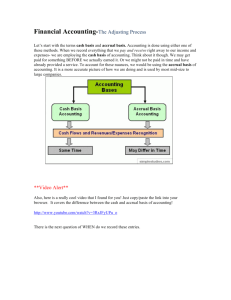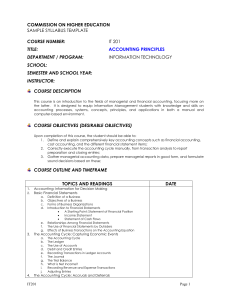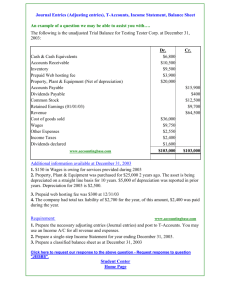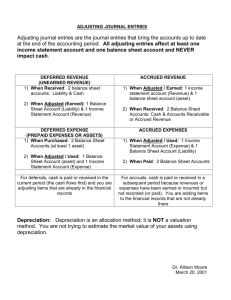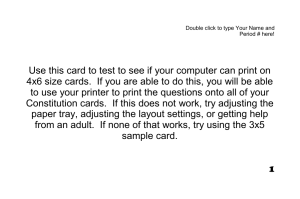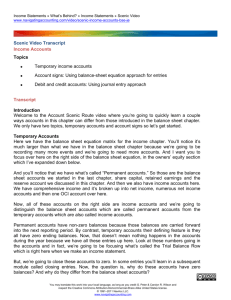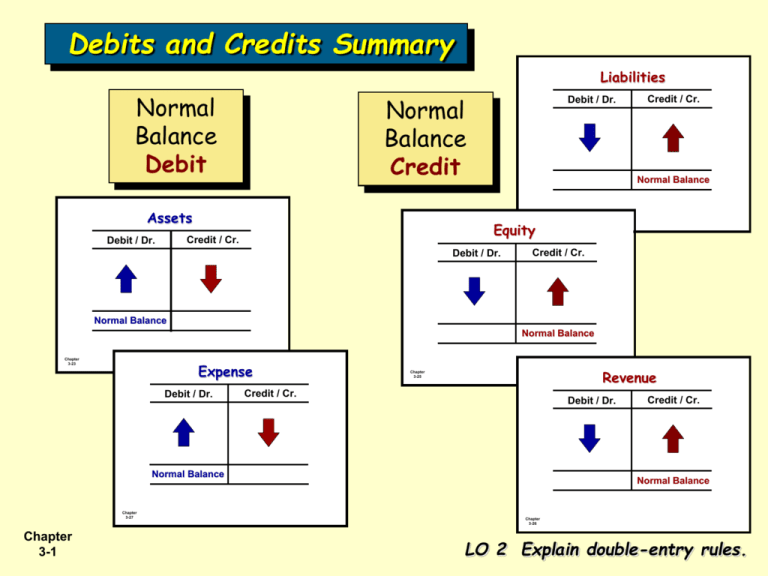
Debits and Credits Summary
Liabilities
Normal
Balance
Debit
Normal
Balance
Credit
Assets
Credit / Cr.
Normal Balance
Chapter
3-24
Equity
Credit / Cr.
Debit / Dr.
Debit / Dr.
Debit / Dr.
Credit / Cr.
Normal Balance
Normal Balance
Chapter
3-23
Expense
Debit / Dr.
Revenue
Chapter
3-25
Credit / Cr.
Debit / Dr.
Normal Balance
Chapter
3-27
Chapter
3-1
Credit / Cr.
Normal Balance
Chapter
3-26
LO 2 Explain double-entry rules.
Basic Accounting Equation
Relationship among the assets, liabilities and
stockholders’ equity of a business:
Illustration 3-3
The equation must be in balance after every
transaction. For every Debit there must be a Credit.
Chapter
3-2
LO 2 Explain double-entry rules.
Corporation Ownership Structure
Illustration 3-4
Balance Sheet
Stockholders’ Equity
Common Stock
(Investment
by stockholders)
Dividends
Retained Earnings
(Net income retained in business)
Net income or Net loss
(Revenues less expenses)
Income Statement
Statement of Retained Earnings
Chapter
3-3
LO 2 Explain double-entry rules.
The Accounting Cycle
Illustration 3-6
Transactions
9. Reversing entries
1. Journalization
8. Post-closing trail balance
2. Posting
7. Closing entries
3. Trial balance
6. Financial Statements
Work
Sheet
4. Adjustments
5. Adjusted trial balance
Chapter
3-4
LO 3 Identify steps in the accounting cycle.
Transactions and Events
What to Record?
FASB states, “transactions and other events and
circumstances that affect a business enterprise.”
Types of Events:
External – between a business and its environment.
Internal – event occurring entirely within a business.
Chapter
3-5
LO 3 Identify steps in the accounting cycle.
Review “Transactions and Events”
External
1.
Internal
Not Recorded
A supplier of a company‘s raw material is paid
an amount owed on account.
2. A customer pays its open account.
3. A new chief executive officer is hired.
External
External
Not Recorded
4. The biweekly payroll is paid.
External
5. Raw materials are entered into production.
Internal
6. A new advertising agency is hired.
7. The accountant determines the federal income
taxes owed based on the income earned.
Chapter
3-6
Not Recorded
Internal
LO 3 Identify steps in the accounting cycle.
1. Journalizing
General Journal – a chronological record of transactions.
Journal Entries are recorded in the journal.
General Journal
Date
Jan.
3
Account Title
Ref.
Cash
100
Common stock
10
Building
Chapter
3-7
220
Credit
100,000
300
130
Note payable
Debit
100,000
150,000
150,000
LO 4 Record transactions in journals, post to
ledger accounts, and prepare a trial balance.
2. Posting
Posting – the process of transferring amounts from the
journal to the ledger accounts.
General Journal
Date
Jan. 3
Account Title
Cash
GJ1
Ref.
Debit
100
100,000
Common stock
100,000
General Ledger
Cash
Date
Explanation
Jan. 3 Sale of stock
Chapter
3-8
Credit
Ref.
Debit
GJ1
100,000
Acct. No. 100
Credit
Balance
100,000
LO 4 Record transactions in journals, post to
ledger accounts, and prepare a trial balance.
3. Trial Balance
Trial Balance – a list of each account and its balance;
used to prove equality of debit and credit balances.
Acct. No.
100
105
110
130
200
220
300
330
400
500
Chapter
3-9
Account
Cash
Accounts receivable
Inventory
Building
Accounts payable
Note payable
Common stock
Retained earnings
Sales
Cost of goods sold
Debit
Credit
$ 140,000
35,000
30,000
150,000
$
60,000
150,000
100,000
75,000
30,000
$ 385,000
$ 385,000
LO 4 Record transactions in journals, post to
ledger accounts, and prepare a trial balance.
4. Adjusting Entries
Revenues - recorded in the period in which they
are earned.
Expenses - recognized in the period in which they
are incurred.
Adjusting entries - needed to ensure that the
revenue recognition and matching principles are
followed.
Chapter
3-10
LO 5
Explain the reasons for preparing adjusting entries.
Classes of Adjusting Entries
Illustration 3-20
Prepayments
Accruals
1. Prepaid Expenses.
Expenses paid in cash and
recorded as assets before
they are used or consumed.
3. Accrued Revenues.
Revenues earned but not
yet received in cash or
recorded.
2. Unearned Revenues.
Revenues received in cash
and recorded as liabilities
before they are earned.
4. Accrued Expenses.
Expenses incurred but not
yet paid in cash or
recorded.
Chapter
3-11
LO 5
Explain the reasons for preparing adjusting entries.
Adjusting Entries – “Prepaid Expenses”
Payment of cash that is recorded as an asset because
service or benefit will be received in the future.
Cash Payment
BEFORE
Expense Recorded
Prepayments often occur in regard to:
insurance
supplies
advertising
Chapter
3-12
LO 5
rent
maintenance on equipment
fixed assets
Explain the reasons for preparing adjusting entries.
Adjusting Entries – “Prepaid Expenses”
Example: On Jan. 1st, Phoenix Corp. paid $12,000 for 12
months of insurance coverage. Show the journal entry to
record the payment on Jan. 1st.
Jan. 1
Prepaid insurance
12,000
Cash
12,000
Prepaid Insurance
Debit
Credit
12,000
Chapter
3-13
Cash
Debit
Credit
12,000
LO 5
Explain the reasons for preparing adjusting entries.
Adjusting Entries – “Prepaid Expenses”
Example: On Jan. 1st, Phoenix Corp. paid $12,000 for 12
months of insurance coverage. Show the adjusting journal
entry required at Jan. 31st.
Jan. 31
Insurance expense
1,000
Prepaid insurance
Prepaid Insurance
Debit
Credit
12,000
1,000
1,000
Insurance expense
Debit
Credit
1,000
11,000
Chapter
3-14
LO 5
Explain the reasons for preparing adjusting entries.
Adjusting Entries – “Unearned Revenues”
Receipt of cash that is recorded as a liability because
the revenue has not been earned.
Cash Receipt
BEFORE
Revenue Recorded
Unearned revenues often occur in regard to:
rent
airline tickets
school tuition
Chapter
3-15
LO 5
magazine subscriptions
customer deposits
Explain the reasons for preparing adjusting entries.
Adjusting Entries – “Unearned Revenues”
Example: On Nov. 1st, Phoenix Corp. received $24,000 from
Arcadia High School for 3 months rent in advance. Show
the journal entry to record the receipt on Nov. 1st.
Nov. 1
Cash
24,000
Unearned rent revenue
Cash
Debit
Unearned Rent Revenue
Credit
24,000
Chapter
3-16
24,000
Debit
Credit
24,000
LO 5
Explain the reasons for preparing adjusting entries.
Adjusting Entries – “Unearned Revenues”
Example: On Nov. 1st, Phoenix Corp. received $24,000 from
Arcadia High School for 3 months rent in advance. Show
the adjusting journal entry required on Nov. 30th.
Nov. 30
Unearned rent revenue
8,000
Rent revenue
Rent Revenue
Debit
8,000
Unearned Rent Revenue
Credit
8,000
Debit
8,000
Credit
24,000
16,000
Chapter
3-17
LO 5
Explain the reasons for preparing adjusting entries.
Adjusting Entries – “Accrued Revenues”
Revenues earned but not yet received in cash or
recorded.
Adjusting entry results in:
Revenue Recorded
BEFORE
Cash Receipt
Accrued revenues often occur in regard to:
rent
interest
services performed
Chapter
3-18
LO 5
Explain the reasons for preparing adjusting entries.
Adjusting Entries – “Accrued Revenues”
Example: On July 1st, Phoenix Corp. invested $300,000 in
securities that return 5% interest per year. Show the
journal entry to record the investment on July 1st.
July 1
Investments
300,000
Cash
300,000
Investments
Debit
Credit
300,000
Chapter
3-19
Cash
Debit
Credit
300,000
LO 5
Explain the reasons for preparing adjusting entries.
Adjusting Entries – “Accrued Revenues”
Example: On July 1st, Phoenix Corp. invested $300,000 in
securities that return 5% interest per year. Show the
adjusting journal entry required on July 31st.
July 31
Interest receivable
1,250
Interest revenue
Interest Receivable
Debit
Credit
1,250
Chapter
3-20
1,250
Interest Revenue
Debit
Credit
1,250
LO 5
Explain the reasons for preparing adjusting entries.
Adjusting Entries – “Accrued Expenses”
Expenses incurred but not yet paid in cash or
recorded.
Adjusting entry results in:
Expense Recorded
BEFORE
Cash Payment, if any*
Accrued expenses often occur in regard to:
rent
interest
taxes
Chapter
3-21
salaries
bad debts*
LO 5
Explain the reasons for preparing adjusting entries.
Adjusting Entries – “Accrued Expenses”
Example: On Feb. 2nd, Phoenix Corp. borrowed $200,000 at a
rate of 9% per year. Interest is due on first of each month.
Show the journal entry to record the borrowing on Feb. 2nd.
Feb. 2
Cash
200,000
Notes payable
Cash
Debit
Notes Payable
Credit
200,000
Chapter
3-22
200,000
Debit
Credit
200,000
LO 5
Explain the reasons for preparing adjusting entries.
Adjusting Entries – “Accrued Expenses”
Example: On Feb. 2nd, Phoenix Corp. borrowed $200,000 at a
rate of 9% per year. Interest is due on first of each month.
Show the adjusting journal entry required on Feb. 28th.
Feb. 28
Interest expense
1,500
Interest payable
Interest Expense
Debit
Credit
1,500
Chapter
3-23
1,500
Interest Payable
Debit
Credit
1,500
LO 5
Explain the reasons for preparing adjusting entries.
5. Adjusted Trial Balance
Shows the balance of all accounts, after adjusting
entries, at the end of the accounting period.
Chapter
3-24
LO 5
Explain the reasons for preparing adjusting entries.
6. Preparing Financial Statements
Financial Statements are prepared directly from the
Adjusted Trial Balance.
Balance
Sheet
Chapter
3-25
Income
Statement
Statement
of
Retained
Earnings
Statement
of Cash
Flows
LO 6 Prepare financial statement from the adjusted trial balance.
6. Preparing Financial Statements
Assume the following
Adjusted Trial Balance
Adjusted Trial Balance
Debit
Cash
Accounts receivable
Building
Note payable
Common stock
Retained earnings
Dividends declared
Sales
Interest income
Cost of goods sold
Salary expense
Depreciation expense
$ 140,000
35,000
190,000
Chapter
3-26
Balance Sheet
Credit
$ 150,000
100,000
38,000
10,000
185,000
17,000
47,000
25,000
43,000
$ 490,000
$ 490,000
Balance Sheet
Assets
Cash
Accounts receivable
Building
Total assets
Liabilities
Note payable
Stockholders' equity
Common stock
Retained earnings
Total liab. & equity
$ 140,000
35,000
190,000
$ 365,000
150,000
100,000
115,000
$ 365,000
LO 6 Prepare financial statement from the adjusted trial balance.
6. Preparing Financial Statements
Assume the following
Adjusted Trial Balance
Adjusted Trial Balance
Debit
Cash
Accounts receivable
Building
Note payable
Common stock
Retained earnings
Dividends declared
Sales
Interest income
Cost of goods sold
Salary expense
Depreciation expense
$ 140,000
35,000
190,000
Chapter
3-27
Income Statement
Credit
$ 150,000
100,000
38,000
10,000
185,000
17,000
47,000
25,000
43,000
$ 490,000
Income Statement
Revenues:
Sales
Interest income
Total revenue
Expenses:
Cost of goods sold
Salary expense
Depreciation expense
Total expenses
Net income
$ 185,000
17,000
202,000
47,000
25,000
43,000
115,000
$ 87,000
$ 490,000
LO 6 Prepare financial statement from the adjusted trial balance.
6. Preparing Financial Statements
Statement of
Retained Earnings
Assume the following
Adjusted Trial Balance
Adjusted Trial Balance
Debit
Cash
Accounts receivable
Building
Note payable
Common stock
Retained earnings
Dividends declared
Sales
Interest income
Cost of goods sold
Salary expense
Depreciation expense
$ 140,000
35,000
190,000
Chapter
3-28
Credit
$ 150,000
100,000
38,000
Statement of Retained Earnings
Beginning balance
+ Net income
- Dividends
Ending balance
$
38,000
87,000
(10,000)
115,000
10,000
185,000
17,000
47,000
25,000
43,000
$ 490,000
$ 490,000
LO 6 Prepare financial statement from the adjusted trial balance.
7. Closing Entries
To reduce the balance of the income statement
(revenue and expense) accounts to zero.
To transfer net income or net loss to owner’s
equity.
Balance sheet (asset, liability, and equity)
accounts are not closed.
Dividends are closed directly to the Retained
Earnings account.
Chapter
3-29
LO 7 Prepare closing entries.
7. Closing Entries
Example: Assume the following Adjusted Trial Balance
Acct. No.
100
105
130
220
300
330
380
400
430
500
520
550
Chapter
3-30
Account
Cash
Accounts receivable
Building
Note payable
Common stock
Retained earnings
Dividends declared
Sales
Interest income
Cost of goods sold
Salary expense
Depreciation expense
Debit
Credit
$ 140,000
35,000
190,000
$ 150,000
100,000
38,000
10,000
185,000
17,000
47,000
25,000
43,000
$ 490,000
$ 490,000
LO 7 Prepare closing entries.
7. Closing Entries
Example: Prepare the Closing journal entry from the
adjusted trial balance on the previous slide.
Chapter
3-31
Sales
Interest income
Income summary
185,000
17,000
Income summary
Cost of goods sold
Salary expense
Depreciation expense
115,000
Income summary
Retained earnings
87,000
Retained earnings
Dividends declared
10,000
202,000
47,000
25,000
43,000
87,000
10,000
LO 7 Prepare closing entries.
8. Post-Closing Trial Balance
Example continued:
Acct. No.
100
105
130
220
300
330
380
400
430
500
520
550
Chapter
3-32
Account
Cash
Accounts receivable
Building
Note payable
Common stock
Retained earnings
Dividends declared
Sales
Interest income
Cost of goods sold
Salary expense
Depreciation expense
Debit
Credit
$ 140,000
35,000
190,000
$ 150,000
100,000
115,000
$ 365,000
$ 365,000
LO 7 Prepare closing entries.
9. Reversing Entries
Reversing entries is an optional step that
a company may perform at the beginning
of the next accounting period.
Chapter
3-33
LO 7 Prepare closing entries.
Copyright
Copyright © 2007 John Wiley & Sons, Inc. All rights reserved.
Reproduction or translation of this work beyond that permitted
in Section 117 of the 1976 United States Copyright Act without
the express written permission of the copyright owner is
unlawful. Request for further information should be addressed
to the Permissions Department, John Wiley & Sons, Inc. The
purchaser may make back-up copies for his/her own use only
and not for distribution or resale. The Publisher assumes no
responsibility for errors, omissions, or damages, caused by the
use of these programs or from the use of the information
contained herein.
Chapter
3-34

